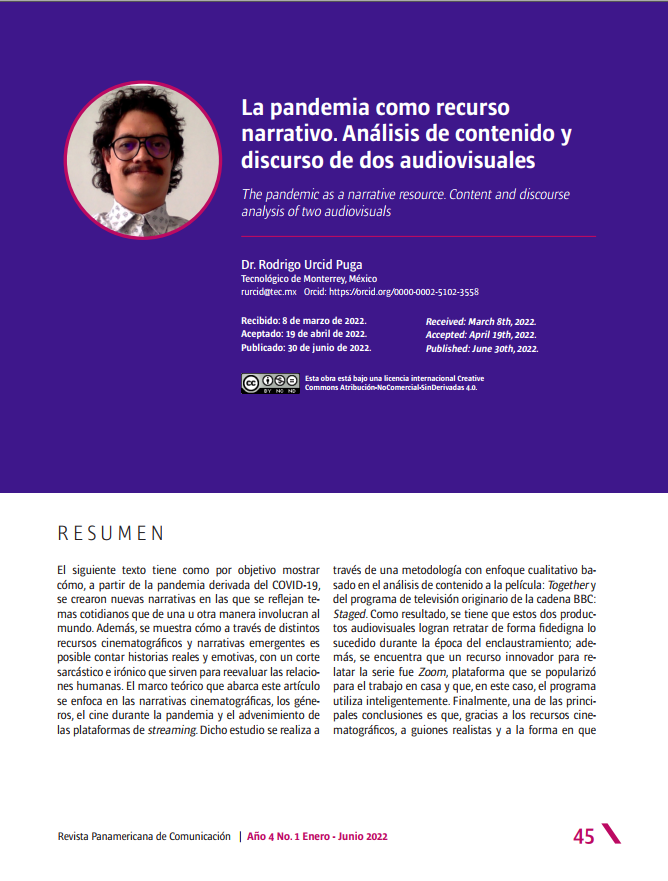La pandemia como recurso narrativo. Análisis de contenido y discurso de dos audiovisuales
Contenido principal del artículo
Resumen
El siguiente texto tiene como por objetivo mostrar cómo, a partir de la pandemia derivada del COVID-19, se crearon nuevas narrativas en las que se reflejan temas cotidianos que de una u otra manera involucran al mundo. Además, se muestra cómo a través de distintos recursos cinematográficos y narrativas emergentes es posible contar historias reales y emotivas, con un corte sarcástico e irónico que sirven para reevaluar las relaciones humanas. El marco teórico que abarca este artículo se enfoca en las narrativas cinematográficas, los géneros, el cine durante la pandemia y el advenimiento de las plataformas de streaming. Dicho estudio se realiza a través de una metodología con enfoque cualitativo basado en el análisis de contenido a la película: Together y del programa de televisión originario de la cadena BBC: Staged. Como resultado, se tiene que estos dos productos audiovisuales logran retratar de forma fidedigna lo sucedido durante la época del enclaustramiento; además, se encuentra que un recurso innovador para relatar la serie fue Zoom, plataforma que se popularizó para el trabajo en casa y que, en este caso, el programa utiliza inteligentemente. Finalmente, una de las principales conclusiones es que, gracias a los recursos cinematográficos, a guiones realistas y a la forma en que se trabaja la narrativa, la industria del entretenimiento, en particular el cine y la televisión tienen oportunidades de crear nuevos contenidos a partir de momentos históricos.
Detalles del artículo
Sección

Esta obra está bajo una licencia internacional Creative Commons Atribución-NoComercial-SinDerivadas 4.0.
Cómo citar
Referencias
» Altman, R. (2020). Los géneros cinematográficos. Ciudad de México, Paidós.
» Ayala, J. (2012). El cine actual, estallidos genéricos. Ciudad de México, Cineteca Nacional.
» Calderón, J. (2021). El cine post pandemia: la transformación de una industria. Morelia, Universidad Latina de América.
» Cortés, M. (11 de abril de 2022). El 67% de los mexicanos visualizó contenido a través de streaming durante la pandemia. CIO México. Consultado el 12 de abril de 2022. En línea: https://cio.com.mx/apps-de-fitness-en-mexico-ya-superan-las-9-millones-de-horas-de-uso-en-tan-solo-un-ano/
» Gutiérrez, A. L. (20 de noviembre de 2020). Pandemia impulsa 26% los ingresos de aplicaciones de streaming este año. El Financiero. Consultado el 26 de febrero de 2022. En línea: https://www.elfinanciero.com.mx/empresas/pandemia-impulsa-26-los-ingresos-de-aplicaciones-de-streaming-este-ano/
» Feldman, S. (2012). La realización cinematográfica. Barcelona, Gedisa.
» Fulford, L. (s.f). Cambios en la industria cinematográfica a raíz del coronavirus. Consultado el 25 de febrero de 2022. En línea: https://www.canon.es/pro/stories/filmmaking-after-lockdown/
» Gaudreault, A. y Jost, F. (2015). El relato cinematográfico. Ciencia y narratología. Ciudad de México, Paidós.
» Godoy, J. (11 de noviembre de 2020). Televisión objetivo, desbancar a Netflix: el negocio del streaming explota con la pandemia. El País. Consultado el 25 de febrero de 2022. En línea: https://elpais.com/retina/2020/11/11/innovacion/1605118952_313914.html
» Guigues, S.L. y Leutrat, J.L. (2013). Cómo pensar el cine. Madrid, Cátedra.
» International Movie Database (2022). Staged. Consultado el 1º de marzo de 2022. En l línea: https://www.imdb.com/title/tt14640242/?ref_=fn_al_tt_1
» International Movie Database (2022). Together. Consultado el 1º de marzo de 2022. En línea: https://www.imdb.com/title/tt14640242/?ref_=fn_al_tt_1
» Labelium (2020). COVID-19: el poder del streaming para conectar con los usuarios durante el confinamiento. Labelium Group. Consultado el 1º de marzo de 2022. En línea: https://www.labelium.com/blog/es/streaming-conectar-usuarios-confinamiento/
» Marquines, O. y Añasco, O. (2014). Entretenimiento y streaming en la nube. Tesis de Licenciatura. Ecuador: Escuela Superior Politécnica del Litoral.
» Martin, M. (2018). El lenguaje del cine. Barcelona, Gedisa.
» Refojos, S. (2020). 2020, el año del streaming: así está cambiando el mundo esta tendencia. El Periódico. Consultado el 25 de febrero de 2022. En línea: https://www.elperiodico.com/es/activos/innovadores/20201028/2020-el-ano-del-streaming-asi-estacambiando-el-mundo-esta-tendencia-8176452
» Rotten Tomatoes (2022). Staged. Consultado el 24 de febrero de 2022. En línea: https://www.rottentomatoes.com/tv/staged.
» Rotten Tomatoes (2022). Together. Consultado el 24 de febrero de 2022. En línea: https://www.rottentomatoes.com/m/together_2021
» Sánchez, M. (2021). El cine en la COVID-19. Ciudad de México, Universidad Nacional Autónoma de México.
» Tuñón, J. y Gambari, A. (2021). Plataformas audiovisuales digitales: las grandes vencedoras de la pandemia. Barcelona, OBS Business School.
» Vanoye, F y Lété, F. (2018). Principios de análisis cinematográfico. Madrid, ABADA Editores.

